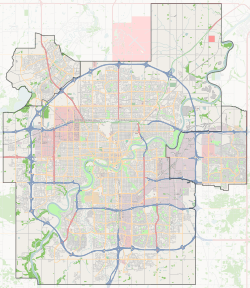Kensington, Edmonton
Kensington is a residential neighbourhood in north west Edmonton, Alberta, Canada. While the land was annexed by Edmonton in 1913, development of the neighbourhood didn't occur until much later.
Kensington | |
|---|---|
Neighbourhood | |
 Kensington Location of Kensington in Edmonton | |
| Coordinates: 53.596°N 113.528°W | |
| Country | |
| Province | |
| City | Edmonton |
| Quadrant[1] | NW |
| Ward[1] | 2 |
| Sector[2] | Mature area |
| Government | |
| • Administrative body | Edmonton City Council |
| • Councillor | Bev Esslinger |
| Area | |
| • Total | 1.32 km2 (0.51 sq mi) |
| Elevation | 680 m (2,230 ft) |
| Population (2012)[5] | |
| • Total | 3,595 |
| • Density | 2,723.5/km2 (7,054/sq mi) |
| • Change (2009–12) | |
| • Dwellings | 1,753 |
According to the 2001 federal census three in ten (27.8%) of residences in the neighbourhood were built shortly after the end of World War II, that is, between 1946 and 1960. Another four in ten residences (37.0%) were built during the 1960s. There was little new development in the neighbourhood until the mid-1990s. Between 1996 and 2000, there was a sharp increase in the number of residences constructed with another one in five (21.8%) being built during this period.[6]
In 2005, the most common type of residence in the neighbourhood was the single-family dwelling. These accounted for six out of ten (63%) of the residences in the neighbourhood. Rented apartments and apartment style condominiums accounted for another one in four (23%) of residences. Duplexes accounting for one in eight (12%) or residences.[7] The remaining 2% of residences were row houses. Seven out of ten (71%) or residences were owner occupied, while three out of ten (29%) were rented.[8]
There is a single school in the neighbourhood, Kensington Elementary School, operated by the Edmonton Public School System. Since September 2011, a portion of Kensington School is leased to the Greater North Central Francophone Education Region No. 2 which operates a Kindergarten to grade 6 francophone school, École À la Découverte.
The community is represented by the Kensington Community League, established in 1960, which maintains a community hall and outdoor rink located at 121 Street and 134A Avenue.[9][10]
Demographics
In the City of Edmonton's 2012 municipal census, Kensington had a population of 3,595 living in 1,753 dwellings,[5] a -6% change from its 2009 population of 3,824.[11] With a land area of 1.32 km2 (0.51 sq mi),[4] it had a population density of 2,723.5 people/km2 in 2012.[4][5]
Surrounding neighbourhoods
References
- "City of Edmonton Wards & Standard Neighbourhoods" (PDF). City of Edmonton. Archived from the original (PDF) on May 3, 2014. Retrieved February 13, 2013.
- "Edmonton Developing and Planned Neighbourhoods, 2011" (PDF). City of Edmonton. Archived from the original (PDF) on September 4, 2013. Retrieved February 13, 2013.
- "City Councillors". City of Edmonton. Retrieved February 13, 2013.
- "Neighbourhoods (data plus kml file)". City of Edmonton. Retrieved February 22, 2013.
- "Municipal Census Results – Edmonton 2012 Census". City of Edmonton. Retrieved February 22, 2013.
- http://censusdocs.edmonton.ca/DD23/FEDERAL%202001/Neighbourhood/KENSINGTON.pdf
- Includes triplexes and quadruplexes.
- http://censusdocs.edmonton.ca/C05002/MUNICIPAL%202005/Neighbourhood/KENSINGTON.pdf
- "Kensington Community League". Kensington Community League. Retrieved October 10, 2017.
- Kuban, Ron (2005). Edmonton's Urban Villages: The Community League Movement. University of Alberta Press. ISBN 9781459303249.
- "2009 Municipal Census Results". City of Edmonton. Retrieved February 22, 2013.